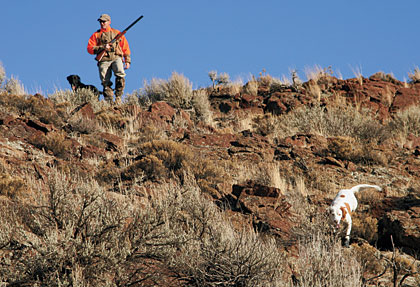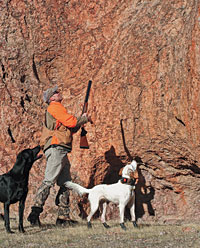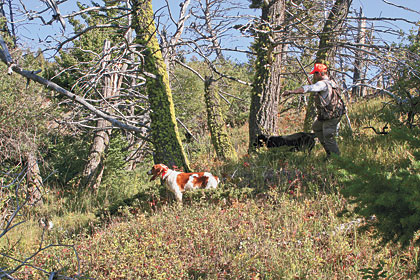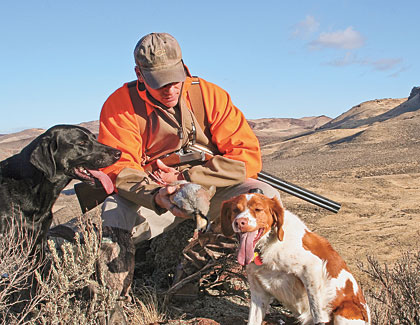Who says you can't hunt pointers alongside flushers?
By Dave Carty
Powder, my Brittany, had been working the bird five minutes before we saw it. We were at nose-bleed elevation in the Bridger Mountains near my home in Bozeman, Montana, higher than I typically hunt. But my friend John Wright, who, among other things, is one of the few serious blue grouse hunters I know, had found birds here before.
 Kevin Hocevar and his Lab, Baxter, in chukar country with the author's setter, Hanna. Hocevar kept his Lab at heel until a bird was shot, then sent him in for a retrieve. But allowing the dog to hunt on its own will also work. |
And so it seemed we would again. Suddenly, Powder froze, and John sent the younger of his two springers, Swami, to make the flush. But several seconds of frantic searching didn't turn up a bird, and John called her back. I released Powder, John called Swami and Profitt, his older dog, back to heel, and we continued to hunt downhill.
That happens a lot with blues. The dog points, you kick around for a bit, but the birds, if ever they were there in the first place, have vanished to parts unknown. No one knows where they go; they may well slip into a parallel universe. Powder, however, wasn't buying it.
Fifty yards on she slammed into a point again. John took a few steps ahead, his dogs at heel, and peered around a tree. Then he motioned me forward. "It's right there," he whispered, pointing tersely. I found an opening in the trees, told Powder to whoa for good measure, and waited.
John sent in Swami, who instantly put the bird into the air and then slammed her butt to the ground as she'd been trained, perfectly steady. Even for a dyslexic wingshot like me it was a gimme, and a few seconds later John sent Swami to retrieve her first wild bird.
When she'd brought it back to hand, I released Powder, and grinning, we celebrated with high fives. We didn't see another bird for the rest of the morning, but it didn't matter. After that performance, anything else would have been as anticlimactic as a tailgate party after the game.
Trust me on this; our dogs don't always work quite so seamlessly. One or both dogs can break, take out the bird, and roll dark clouds across an otherwise clear blue sky. It is for precisely this reason that few trainers recommend hunting pointers and flushers together. Which is probably good advice as far as it goes.
But having grown up in the 1960s and '70s, when questioning authority was the norm, that never really sat well with me. So quite a few years ago, after a self-imposed restriction on running the two breeds together, I decided to give it a try. I owned a springer spaniel and a Brittany in those days, and I figured that if I hunted them together and the whole operation blew up in my face, well, so be it.
 Regardless of what combination of dogs you use, chukar country can provide some insurmountable challenges. |
A RECIPE FOR €¦
Fancy, my Brittany, was nowhere near as far along as the dogs I train today, although my spaniel was reasonably trained -- steady to flush and a solid retriever. I hunted the two in pheasant habitat, where my spaniel was in his element. As I recall, they worked well together.
So what was all the fuss about? Fancy wasn't steady, so occasionally she'd break point when my spaniel, Poke, was thrashing around in the brush hot on the trail of a rooster, but she was broke to whoa, and a sharp command would usually bring her up short again.
Still, something was missing: teamwork. For a pointer and flusher to completely mesh, I realized both had to be trained to a fairly high level. It would be another 10 years before I developed the skills to do that.
Running an out-of-control pointer is bad enough all by itself, but a disaster waiting to happen if you run him with a flusher, who will almost certainly encourage him to break point and give chase. But once a dog is solid on the "whoa" command, usually after it has at least a season of hunting under its belt, hunting it with a flusher is a great opportunity to work on its steadiness.
Think of it this way: A fundamental process in training a dog to do anything involves distractions of escalating levels of intensity, buttressed with corrections when necessary, which reinforces your dog's commitment to obeying the command. You might, for example, reinforce "whoa" by running the dog through his drills on pigeons, then on wild birds, then with another pointer on an actual hunt, and so on. Each time the dog breaks, your correction reinforces the whoa command a bit further.
Nothing will tempt your dog to break more than another dog bouncing around in front of him while he's pointing; but by looking at that not as a disaster but as a training opportunity you'll see how helpful it can be. Of course, that may mean you have to put down your gun and train when you'd rather shoot, but that's life in the big city.
FLUSHING 101
My dogs are (usually) steady to wing, shot and fall, but they weren't always that way, and the same distraction/correction process works for dogs allowed (or encouraged) to break at the shot or flush. So a few years ago, after several years of running my three mutts with each other, I decided to introduce a flusher again.
My old friend Kevin Hocevar and his Lab, Baxter, were game. Kevin lives in Boise, and the two of us team up every year to chase chukars in eastern Oregon. Baxter is a great, handsome beast, one of the best-looking Labs I've ever seen. With a new baby and a fulltime job as a parole officer, Kevin probably hasn't spent as much time training Baxter as he should, but he has trained him to walk reliably at heel for hours at a stretch and the dog would probably fetch a truck axle if Kevin asked him to do it.
Although chukars are usually hunted with pointing dogs, having a good retriever on board is a huge help. Wounded chukars can run down a mountain and halfway up the other side in the time it takes to reload, and most of the pointing breeds, including mine, really aren't up to working that hard in the fetching department. Furthermore, Baxter wasn't steady; still isn't. Could we pair them together without problems?
 Mike England and his Lab/golden cross, Rico, move in on a blue grouse pointed by the author's dogs, Powder (Brittany) and Scarlet (setter, lower left). |
I found the answer on our first day's hunt. After chugging up a narrow, rocky road, leaving tracks in the day-old snow, I dropped the tailgate at the top of a hill and turned out Scarlet, then two or three years old. This would be her first chukar hunt.
An hour later, as we circled the hilltop, Scarlet began working fresh scent. A minute later she pointed, and when I walked in a single blew out at my feet. I scratched it down just as it sailed across a deep ravine.
Knowing I'd wounded the bird, I released the little setter immediately and sent her downhill for the retrieve. But Scarlet hadn't seen the bird fall -- it had dropped below her line of sight -- and simply ran down one side of the ravine and up the other. I called her back, only to have her do the same thing again. It was time to bring in the cavalry.
When Kevin loosed Baxter, the big dog knew exactly where the wounded chukar had gone. He charged into the ravine and began chasing the bird up one side and down the other before snapping it up and bringing it back to Kevin's hand. All this was just fine with Scarlet, who throughout her life has always been happy to let another dog do the dirty work.
OBEDIENCE IS KEY
Of course, many dogs aren't so accommodating. Two dogs chasing the same bird can lead to a hamburgerized bird, a dog fight, or both. That's why it's so important that at least one of the dogs — either the flusher or pointer — is steady.
Few flushers you hunt over will be trained to the level John Wright asks of his dogs, however. With multiple Canadian and American field trial titles to their credit, John's springers could teach most of the Labs in the country a thing or two about obedience. John spends the summers working and trialing his dogs, then finishes them off in the field on wild birds.
He's lucky: above his house is a stretch of ruffed grouse habitat that he uses as his personal training grounds. I'm lucky too -- occasionally he invites me to hunt it with him. One October morning last season we met up for coffee in his kitchen and then set off a half hour later into the woods.
TRICKY TERRAIN
The place is made to order for a flusher/pointer combo hunt. Ravines choked with dense stands of hawthorns hold the birds, which can run about freely in the thin understory beneath the bushes. The dogs can run through the understory too, but for humans it's another story.
 Proof positive. A bird in hand is evidence that pointers and flushers can be hunted together successfully. |
Hawthorns are great grouse habitat because of the berries, called thorn apples, they produce, which the birds love, but also because their intertwining branches are armed with two-inch, razor sharp thorns. If your pointing dog locks up in that stuff, you'll need a blood transfusion after getting it out. You either go in and risk bleeding to death, or you wait for however long it takes for the bird to flush on its own. Spaniels, however, level the playing field.
For most of that morning, John kept his spaniel Seer at heel, while I allowed my two setters, Hanna and Scarlet, to comb the hillsides above. We moved more than a dozen grouse in three hours, many pointed by Scarlet and backed by Hanna. The first was a blue grouse, however, the only one we saw that day. Scarlet pointed, John turned Seer loose, and the bird immediately flew into a tree, ruffling its feathers and peering at the two dogs below. We couldn't get it to flush, so we let it go.
For most of that trip, the dogs worked together quite well, if not altogether seamlessly. Even Seer got into the act when John let him run, flushing several birds my two pointers had missed. In fact, my dogs raced right by the only bird we shot. While both setters were 100 yards up the hill, Seer began acting birdy in the ravine below us. A minute later he popped a grouse out of the thorn apples, and John made a beautiful 45-yard crosser. By the time my two dogs charged back to see what was going on, Seer had already brought the bird to hand.
EXPECTATIONS
I mentioned that my dogs aren't perfect and as much as it pains me to be humble, it's true. Occasionally the tension of watching another dog flush "their" bird gets to be too much and they break. By then it's usually too late to correct them, but their doing so is a sign that I need to set aside my gun on the next point and keep my thumb on the transmitter of their e-collar instead of on the safety of my shotgun.
Is that somehow unfair to the dog? Nope. It may be their bird, but it's my command to whoa, and they've learned to expect consequences for disobeying. That expectation of a correction as much as the correction itself is what keeps them in line.
Eventually, hunting with a flusher becomes no different than hunting with any other dog, at least from their viewpoint. Whoa means whoa no matter who gets to ignore the retrieve. Scarlet, are you listening?






